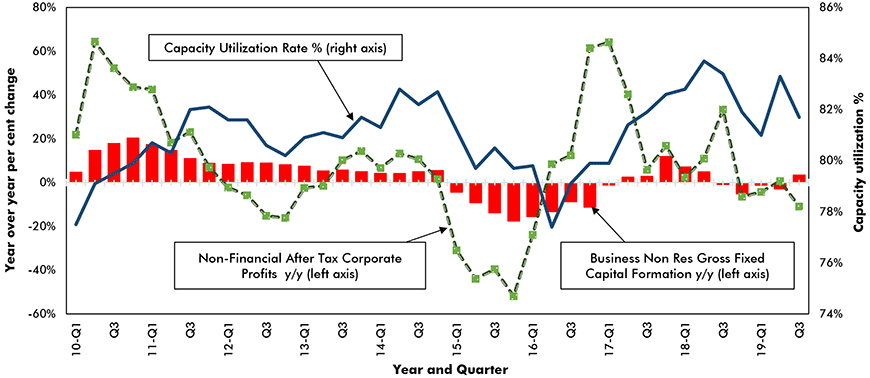After it shrank by -7% q/q in the second quarter, economy watchers were surprised to see business gross fixed non-residential capital formation rebound by 9.5% q/q, (3.4% y/y) in the third quarter. Indeed, this component of domestic demand was the largest contributor to the quarter’s growth, helping to offset the effects of slowing exports and a drawdown in inventories.
All three components of business non-res gross capital formation rose in the third quarter led by engineering structures (+13% q/q at annual rates) followed by machinery and equipment (+7%) and non-res building (+5.8%). Given the lag between the gains in the key drivers of investment and actual spending, it appears that this surge in Q3 spending was in large part the result of the combination of an increase in the after-tax profits of non-financial corporations and an increase in industrial capacity utilization in mid-2018.
As with the prospects for the Canadian economy as a whole, highlighted in Snapshot 23 (“We are still curbing our enthusiasm about growth in 2020”), the near-term outlook for gross fixed non-residential capital formation is hobbled by the recent performance of a number of its key drivers.
First, after posting a slight 0.8% q/q gain in the first quarter of this year, operating profits of non-financial corporations shrank by 0.5% in the third quarter largely on account of a 6.3% drop in manufacturing profits which have contracted in six of the past seven quarters. Despite lower natural gas prices and bottlenecked pipeline infrastructure, the ‘mining, oil and gas industry’ has seen its operating profits, increase by 53% year to date compared to the first three quarters of 2018. Also, both real estate and transportation have also seen solid year-to-date gains in operating profits.
A second key driver of non-residential investment, the capacity utilization rate, has also lost altitude. After hitting a high of 83.9% in the second quarter of 2018, the total capacity utilization rate has trended to 81.7% in Q3, its lowest value since the third quarter of 2017. On a year-over-year basis, the operating rate has declined in four of the five non-manufacturing industries with the exception of the construction industry. Within manufacturing, capacity use was down in fourteen of 21 major industries, led by wood products (-6.3%), chemical products (-4.5%) and primary metal products (-2.7%). To put Canada’s operating rate in context, after hitting a post-financial crisis high of 77.3% in December of 2018, the U.S. industrial capacity utilization rate has trended gradually lower and now stands at 74.7%.
The recently enacted Bill C-69, titled The Modernization of the National Energy Board and the Canadian Environmental Assessment Agency, will have a significant impact on resource projects which account for approximately 20% of total capital spending. While it is difficult to quantify the impact of this new legislation, two of Canada’s most respected think tanks, the Fraser Institute and the C.D. Howe Institute, have called for the government to reconsider it. The opening of the project approval process to multiple intervenors who may not be directly impacted will delay and heighten uncertainty about whether a company can proceed with a major project, an already extremely long approval process. Also, the economic impact of a major project is not expressly accounted for in the criteria for its approval. Third, the bill does not define which five of the 20 mandatory factors the minister of natural resources and the cabinet will use to determine if a project is in the public interest.
Despite the above-noted impediments, there are a couple of factors that should help to support business non-residential construction through 2020 into 2021. High on this list are interest rates which, given Bank of Canada Governor Poloz’s relatively dovish comments, are likely to remain little changed for some time.
Also, although the recently signed USMCA trade agreement will not dramatically change the pre-existing NAFTA trade agreement, its ratification should remove a cloud of uncertainty overshadowing investment in the Canadian economy in general and specifically in motor vehicle manufacturing, generic drug manufacturing, and e-commerce.
Finally, despite the above-noted deterioration in after tax profits and in the overall capacity utilization rate, capital spending plans remain positive among the 100 firms surveyed quarterly by the Bank of Canada. In its latest Business Outlook Survey, the Bank noted that investment plans were generally positive outside the Prairies where firms indicated their investment plans were hobbled by regulation, uncertainty and weak balance sheets. Consistent with our quite subdued outlook for business non-residential capital investment noted above , the Bank’s regional indicator is slightly positive largely due to strength in Quebec and Ontario, which is largely offset by weakness in the Prairies.
John Clinkard has over 35 years’ experience as an economist in international, national and regional research and analysis with leading financial institutions and media outlets in Canada.
Business Non-Res Gross Capital Formation vs
Y/Y% Corporate Profits and Capacity Utilization Rate

Chart: ConstructConnect – CanaData.











Recent Comments